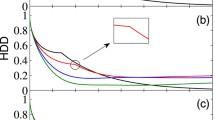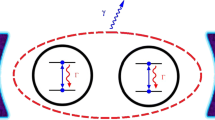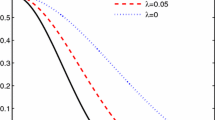Abstract
Dynamics of an open two-qubit system is investigated in the post-Markovian regime, where the environments have a short-term memory. Each qubit is coupled to separate environment which is held in its own temperature. The inter-qubit interaction is modeled by XY–Heisenberg model in the presence of spin–orbit interaction and inhomogeneous magnetic field. The dynamical behavior of entanglement and discord has been considered. The results show that quantum discord is more robust than quantum entanglement, during the evolution. Also the asymmetric feature of quantum discord can be monitored by introducing the asymmetries due to inhomogeneity of magnetic field and temperature difference between the reservoirs. By employing proper parameters of the model, it is possible to maintain nonvanishing quantum correlation at high degree of temperature. The results can provide a useful recipe for studying dynamical behavior of two-qubit systems such as trapped spin electrons in coupled quantum dots.








Similar content being viewed by others
References
Einstein, A., Podolsky, B., Rosen, N.: Can quantum-mechanical description of physical reality be considered complete? Phys. Rev. 47, 777 (1935)
Schrödinger, E.: The present status of quantum mechanics. Die Naturwissenschaften 23, 807 (1935)
Ollivier, H., Zurek, W.H.: Quantum discord: a measure of the quantumness of correlations. Phys. Rev. Lett. 88, 017901 (2001)
Henderson, L., Vedral, V.: Classical, quantum and total correlations. J. Phys. A 34, 6899 (2001)
Hill, S., Wootters, W.K.: Entanglement of a pair of quantum bits. Phys. Rev. Lett. 78, 5022 (1997)
Wootres, W.K.: Entanglement of formation of an arbitrary state of two qubits. Phys. Rev. Lett. 80, 2245 (1998)
Knill, E., Laflamme, R.: Power of one bit of quantum information. Phys. Rev. Lett. 81, 5672 (1998)
Datta, A., Shaji, A., Caves, C.M.: Quantum discord and the power of one qubit. Phys. Rev. Lett. 100, 050502 (2008)
Schlosshauer, M.: Decoherence and the Quantum to Classical Transition. Springer, Berlin (2007)
Vedral, V.: Entanglement production in non-equilibrium thermodynamics. J. Phys. Conf. Ser. 143, 012010 (2009)
Breuer, H.P., Petruccione, F.: The Theory of Open Quantum Systems. Oxford University Press, Oxford (2002)
Wang, J., Batelaan, H., Ponday, J., Starace, A.F.: Entanglement evolution in the presence of decoherence. J. Phys. B At. Mol. Opt. Phys. 39, 4343 (2006)
Scala, M., Migliore, R., Messina, A.: Dissipation and entanglement dynamics for two interacting qubits coupled to independent reservoirs. J. Phys. A Math. Theor. 41, 435304 (2008)
Prosen, T.: Third quantization: a general method to solve master equations for quadratic open Fermi systems. New J. Phys. 10, 043026 (2008)
Quiroga, L., Rodríguez, F.J.: Nonequilibrium thermal entanglement. Phys. Rev. A 75, 032308 (2007)
Sinaysky, I., Petruccione, F., Bargarth, D.: Dynamics of nonequilibrium thermal entanglement. Phys. Rev A 78, 062301 (2008)
Lorenzo, S., Plastina, F., Paternostro, M.: Geometrical characterization of non-Markovianity. Phys. Rev. A 88, 020102(R) (2013)
Bylicka, B., Chruscinski, D., Maniscalco, S.: Non-Markovianity and reservoir memory of quantum channels: a quantum information theory perspective. Sci. Rep. 4, 5720 (2014)
Fanchini, F.F., Karpat, G., Çakmak, B., Castelano, L.K., Aguilar, G.H., Farías, O.J., Walborn, S.P., Souto Ribeiro, P.H., de Oliveira, M.C.: Non-Markovianity through accessible information. Phys. Rev. Lett. 112, 210402 (2014)
Haseli, S., Karpat, G., Salimi, S., Khorashad, A.S., Fanchini, F.F., Çakmak, B., Aguilar, G.H., Walborn, S.P., Souto Ribeiro, P.H.: Non-Markovianity through flow of information between a system and an environment. Phys. Rev. A 90, 052118 (2014)
Haseli, S., Salimi, S., Khorashad, A.S.: A measure of non-Markovianity for unital quantum dynamical maps. Quantum Inf. Process. 14, 3581 (2015)
Reina, J.H., Quiroga, L., Johnson, N.F.: NMR-based nanostructure switch for quantum logic. Phys. Rev. B 62, R2267 (2000)
Imamoḡlu, A., Knill, E., Tian, L., Zoller, P.: Optical pumping of quantum-dot nuclear spins. Phys. Rev. Lett. 91, 017402 (2003)
Khaetskii, A., Loss, D., Glazman, L.: Electron spin evolution induced by interaction with nuclei in a quantum dot. Phys. Rev. B 67, 195329 (2003)
Stepanko, D., Burkard, G.: Enhancement of electron spin coherence by optical preparation of nuclear spins. Phys. Rev. Lett. 96, 136401 (2006)
Lai, C.W., Maletinsky, P., Imamoḡlu, A.: Knight-field-enabled nuclear spin polarization in single quantum dots. Phys. Rev. Lett. 96, 167403 (2006)
Loss, D., Divincenzo, D.P.: Quantum computation with quantum dots. Phys. Rev. A 57, 120 (1998)
Burkard, G., Loss, D., Divincenzo, D.P.: Coupled quantum dots as quantum gates. Phys. Rev. B 59, 2070 (2002)
DiVincenzo, D.: Two-bit gates are universal for quantum computation. Phys. Rev. A 51, 1015 (1995)
Legel, S., König, J., Bukard, G., Schön, G.: Generation of spin entanglement in nonequilibrium quantum dots. Phys. Rev. B 76, 085335 (2007)
Legel, S., König, J., Schön, G.: Generation and detection of a spin entanglement in nonequilibrium quantum dots. New J. Phys. 10, 045016 (2008)
Kavokin, K.V.: Anisotropic exchange interaction of localized conduction-band electrons in semiconductors. Phys. Rev. B 64, 075305 (2001)
Dzyaloshinski, I.: A thermodynamic theory of weak ferromagnetism of antiferromagnetics. J. Phys. Chem. Solids 4, 241 (1958)
Moriya, T.: Theory of magnetism of NiF2. Phys. Rev. 117, 635 (1960)
Moriya, T.: New mechanism of anisotropic superexchange interaction. Phys. Rev. Lett. 4, 228 (1960)
Moriya, T.: Anisotropic superexchange interaction and weak ferromagnetism. Phys. Rev. 120, 91 (1960)
Kheirandish, F., Akhtarshenas, S.J., Mohammadi, H.: Effect of spin–orbit interaction on entanglement of two-qubit Heisenberg XYZ systems in an inhomogeneous magnetic field. Phys. Rev. A 77, 042309 (2008)
Kheirandish, F., Akhtarshenas, S.J., Mohammadi, H.: Non-equilibrium entanglement dynamics of a two-qubit Heisenberg XY system in the presence of an inhomogeneous magnetic field and spin–orbit interaction. Eur. Phys. J. D 57, 129 (2010)
Shabani, A., Lidar, D.A.: Completely positive post-Markovian master equation via a measurement approach. Phys. Rev. A 71, 020101(R) (2005)
Dieterich, E., et al.: Single-molecule measurement of the effective temperature in non-equilibrium steady states. Nature 11, 971 (2015)
Campbell, S., et al.: Critical assessment of two-qubit post-Markovian master equations. Phys. Rev. A 85, 032120 (2012)
Budini, A.A.: Post-Markovian quantum master equations from classical environment fluctuations. Phys. Rev. E 89, 012147 (2014)
Sinaysky, I., Petruccione, F.: Markovian and post-Markovian dynamics of nonequilibrium thermal entanglement. arXiv:0905.0544 [quant-ph] (2009)
Werlang, T., Rigolin, G.: Thermal and magnetic quantum discord in Heisenberg models. Phys. Rev. A 81, 044101 (2010)
Ferraro, A., et al.: Almost all quantum states have nonclassical correlations. Phys. Rev. A 81, 052318 (2010)
Acknowledgements
The author wishes to thank The Office of Graduate Studies and Research Vice President of The University of Isfahan for their support.
Author information
Authors and Affiliations
Corresponding author
Appendix 1: Elements of matrix P
Appendix 1: Elements of matrix P
The elements of matrix \(P(t)=[p_{ij}]_{4\times 4}\) in Eq. (18) can be written as follows:
Here we have defined \(X_{\mu }=X_{\mu }^{+}+X_{\mu }^{-}\) and \(Y_{\mu }=Y_{\mu }^{+}+Y_{\mu }^{-}\).
Rights and permissions
About this article
Cite this article
Mohammadi, H. Post-Markovian dynamics of quantum correlations: entanglement versus discord. Quantum Inf Process 16, 39 (2017). https://doi.org/10.1007/s11128-016-1451-4
Received:
Accepted:
Published:
DOI: https://doi.org/10.1007/s11128-016-1451-4




